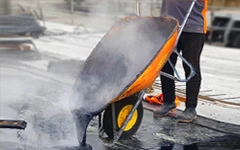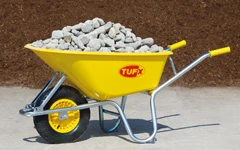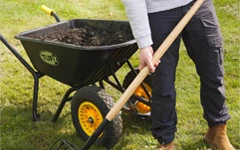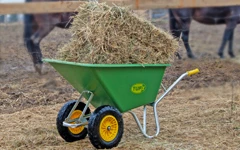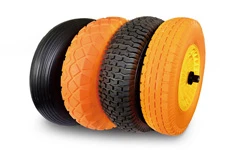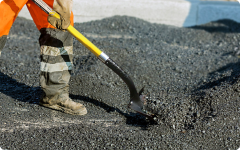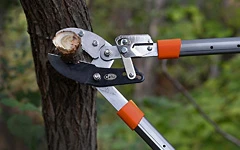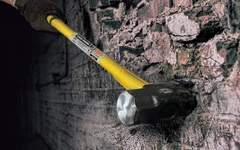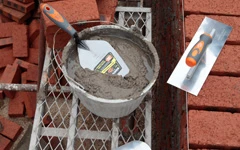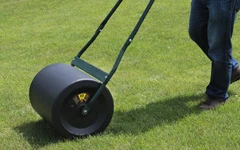Hello, guys! Let’s talk about wheelbarrow today. Speaking of wheelbarrow, what kind of things come to your mind? Lawn? Concrete? Garden?or something else? It seems that wheelbarrow is a simple tool, but do you know the tips about how to choose a premier heavy duty wheelbarrow? what does “sturdy and durable” really mean? It's not just about size—it hinges on structure and materials. Structure determines functionality, so how can we leverage precise, well-thought-out designs to maximize utility? That's one of the key questions we need to explore. When it comes to picking a heavy-duty wheelbarrow, here is what you need to focus on.
Different materials of trays
Let's start by examining the most crucial load-bearing component of a wheelbarrow—the tray. As the part that directly bears the weight of goods, the material choice for the tray directly impacts the cart's load capacity, service life, and safety performance. Currently, there are two main types of trays on the market: steel and poly, each with distinct characteristics suited for different scenarios.
Steel trays are typically made from cold-rolled or galvanized steel sheet, offering high hardness and strength, along with excellent impact resistance. They are particularly suitable for construction sites, logistics warehouses, and other scenarios requiring frequent transport of heavy goods. Also, steel has some drawbacks—compared to poly and aluminum, its higher density makes the bed heavier, which can increase effort during transport. Additionally, steel beds are prone to rust when exposed to acidic and alkaline substances or humid environments. To prevent this, users should periodically apply anti-rust coatings.
On the other hand, poly trays are significantly lighter due to their inherently lightweight material, making them easier to handle—ideal for frequent transport of fertilizers, potted plants, or other tasks where reducing physical strain improves efficiency. Another advantage is their chemical stability: poly resists corrosion from acids, alkalis, and moisture, requiring no maintenance. The abrasion resistant surface also provides cushioning, protecting fragile or scratch-prone items from vibration damage during transit. When choosing, consumers should weigh factors like usage frequency, load requirements, and operating environment. Also, check how the tray attaches to the frame to ensure stability. There’s no universal “best” option—the right choice depends on your specific needs.
The shape and design of a wheelbarrow’s tray are crucial considerations for a sturdy and durable wheelbarrow, with different designs tailored to various usage scenarios.
Different design of trays
The first type is the “rectangular tray”, characterized by a completely flat base and sides that are nearly perpendicular to the bottom. This design maximizes internal space efficiency, making it ideal for loading regular-shaped construction materials. The vertical sidewalls allow for tightly packed cargo, minimizing movement during transport and improving loading efficiency. Additionally, the rectangular tray has a simple structure and relatively easy manufacturing process, making it a cost-effective choice for customers with limited budgets and modest capacity requirements.
The second type is the “semi-circular tray”, featuring a seamless curved design for both the base and sides, creating a smooth, rounded profile without sharp edges. This unique structure is particularly suitable for transporting loose bulk materials such as sand, grain, coal, or fertilizer. The curved design naturally directs materials toward the bottom during transport, ensuring smoother flow inside the hopper. Moreover, the natural curvature of the inner walls allows free-flowing materials to discharge more easily, reducing residue and helping customers save on material waste.
The third type is the “trapezoidal hopper”, which has an outward-sloping front side, forming a wider-top, narrower-bottom structure. The inclined sidewalls distribute goods pressure more evenly, reducing localized wear and extending the tray's lifespan. Another obvious advantage is that, with the same base dimensions, the sloped sides increase usable space, enhancing overall capacity. Additionally, the trapezoidal shape lowers the tray’s center of gravity, improving stability on rough terrain or during turns and reducing the risk of tipping. As a result, trapezoidal hoppers are widely used in construction sites, mining operations, and other scenarios requiring frequent loading and unloading in challenging environments.
In the manufacturing of steel trays, some producers incorporate a rolled edge design—a technique where the upper edges of the tray are bent outward, forming either a rounded or angled curved profile. But what exactly is the purpose of this design, and how does it enhance functionality?
What is Rolled Edge Design?
Rolled edges are created by mechanically folding and compressing the tray’s rim, reinforcing what would otherwise be a vulnerable sharp edge. This process transforms the thin, exposed perimeter into a thicker, more robust structure, significantly improving durability.
Key Benefits of Rolled Edges
This design makes the trays stronger by folding and reinforcing the edges. The folded edges won't bend or break as easily when bumped, carrying heavy loads, or when materials rub against them, so the trays will last longer.
It's also safer for workers won't get cut when loading、unloading or cleaning it, and it won't scratch the items being transported. For trays carrying loose materials like sand or grain, the folded edges help keep everything inside without spilling out the sides.
Plus, the thicker folded edges make it easier to attach other parts of the cart securely, keeping the whole thing nice and sturdy.
About frames
The frame design plays a critical role in wheelbarrows. The frame’s structure directly affects its load capacity, durability, and safety. Many manufacturers don't use one-piece frames - instead, they assemble them through welding, riveting, or bolting. However, these methods have noticeable drawbacks. For example, welded joints tend to develop cracks after prolonged use on bumpy roads or when carrying uneven loads. In severe cases, the connections might even break. Riveted frames handle vibrations better, but require precise alignment between holes and rivets. After extended use, owners need to regularly check for loose connections. Bolted frames face similar issues as riveted ones in high-vibration environments. What’s worse, bolts may wear down their mounting holes over time, creating gaps and deformation that compromise stability.
About handles
Now let's talk about the handle - the part users directly interact with. The feel of the handle creates that crucial first impression of the handcart. Most manufacturers install rubber or plastic grips on the handles to prevent slipping, absorb shocks, and improve the overall user experience. The grip's texture and thickness make a real difference - too thin and it feels cheap, too thick and it becomes uncomfortable during prolonged use. Smart designs often incorporate ergonomic contours that fit naturally in the palm, reducing hand fatigue when pushing heavy loads. Some premium models even add foam padding or gel inserts for extra comfort. After all, when you're moving heavy materials across a job site or garden, those little comfort details can make all the difference between a tool you tolerate and one you actually enjoy using.
About tires
Finally, let's take a close look at the component of wheelbarrows - the wheel system. In the area of heavy-duty wheelbarrow, wheels are primarily divided into two major types: pneumatic tires and flat-free tires, with significant differences in their performance characteristics.
Pneumatic tires demonstrate exceptional shock absorption capabilities on complex terrain. When a hand truck travels over rough, uneven surfaces, pneumatic tires effectively cushion ground impacts, significantly reducing vibration transmission to the truck's frame while substantially decreasing the shock load on the user's joints. Additionally, the lightweight nature of pneumatic tires reduces pushing resistance when carrying heavy loads, thereby improving operational convenience.
Solid tires excel with their outstanding puncture resistance. These tires completely eliminate the risk of flats caused by sharp objects (such as gravel, metal fragments, etc.), ensuring reliable operation. However, the higher material density of solid tires results in increased overall weight, requiring users to exert more physical effort during transportation tasks.
Ending
After gaining an in-depth understanding of its structural construction, have you mastered the key elements for evaluating heavy-duty hand trucks? From the initial trays design to the final wheel design, every small detail profoundly impacts the wheelbarrow’s usability and work efficiency. Fundamentally, while wheelbarrows are merely auxiliary tools to help us achieve end goals, selecting one with rational structural design and superior materials can often deliver twice the result with half the effort.
Finally, we sincerely hope this comprehensive product guide will provide you with genuinely useful insights. When you next shop for a wheelbarrow, you'll be able to expertly assess: the grade of steel used in the frame, the quality of welding workmanship, how well the design suits your needs, also the pros and cons of different tire materials for your specific working conditions. This specialized knowledge will help you quickly identify truly high-quality options among the myriad of products available.
After all, a well-crafted hand truck isn’t just a work tool - it becomes a trusted companion for years to come. It will steadfastly bear heavy loads under scorching sun at construction sites, navigate steadily through muddy warehouse floors, and witness your hard work year after year. Choosing such a “reliable old partner” is worth your careful consideration, because true quality always lies in the details.
